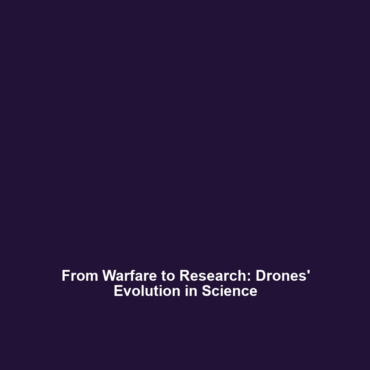Historical Context: Early Uses of Drones in Military Applications and their Transition to Scientific Research
Introduction
The historical journey of drones from military agents to invaluable tools in scientific research is integral to understanding the current landscape of drones in science. Initially developed for reconnaissance and combat purposes during military operations, drones have evolved significantly to serve diverse scientific applications, from environmental monitoring to agricultural assessments. This transition underscores the technological advancements and innovative applications of drones in science, broadening their significance in various research domains.
Key Concepts
Origins in Military Usage
The earliest uses of drones, or unmanned aerial vehicles (UAVs), began during the early 20th century, primarily in military contexts. The development of the Kettering Bug during World War I marked a pivotal point as it provided a glimpse into the potential of pilotless flight for combat reconnaissance.
Transition to Scientific Research
As technology advanced, the adaptability of drones caught the attention of the scientific community. Their ability to collect data from various altitudes and inaccessible terrains paved the way for enthusiastic adoption in environmental studies, wildlife research, and disaster management.
Applications and Real-World Uses
The applications of drones in scientific research are manifold. Notable examples include:
- Agricultural Surveys: Drones are employed extensively to monitor crop health and optimize yield through aerial imaging.
- Environmental Monitoring: UAVs facilitate high-resolution mapping of ecosystems, offering crucial data on climate change impacts.
- Wildlife Research: Researchers use drones to track animal movements and behaviors in their natural habitats, minimizing human disturbance.
These applications demonstrate how early military developments in drone technology have significantly contributed to advancements in drones in science.
Current Challenges
Despite the advancements, there are several challenges associated with integrating early military drone technologies into scientific research:
- Regulatory Issues: Compliance with aviation regulations can hinder drone usage.
- Technical Limitations: Battery life and payload capacity continue to pose challenges for extended research missions.
- Data Management: The vast amount of data collected requires efficient processing and analysis methods.
Addressing these challenges is critical for enhancing the effectiveness of drones in scientific settings.
Future Research and Innovations
Looking forward, emerging technologies are set to reshape the role of drones in science. Innovations such as:
- AI Integration: The deployment of artificial intelligence can improve data analysis capabilities, enabling real-time decision-making.
- Swarm Technology: Research into swarming capabilities could allow multiple drones to collaborate on data collection and mapping tasks.
- Remote Sensing Advancements: Enhanced sensor technologies may significantly expand the range and accuracy of data collection.
These innovations hold great promise for the future landscape of drones in science, making them indispensable research tools.
Conclusion
The historical context of drones, from their military origins to their current applications in scientific research, illustrates a remarkable evolution of technology. This transition not only enhances various research fields but also indicates the potential for future innovations. As we continue to explore and expand the capabilities of drones, it is crucial to address existing challenges to ensure their responsible and effective use in science. For more insights into advancements in drone technology or current environmental research initiatives, continue exploring our resources.

Leave a Reply